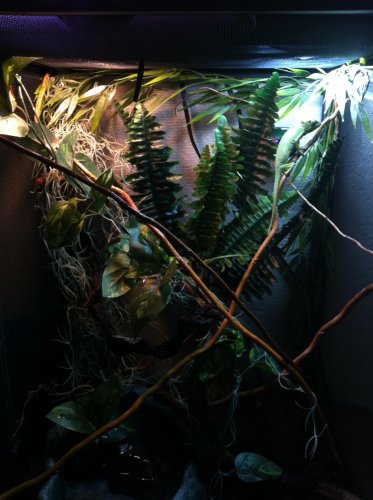Steventomas
New Member
Hi,
Yesterday i purchased my first chameleon and all the supplies. She is a Senegal chameleon i bought from a locally owned pet shop, she was bred by a lady in southern California and sold to my pet shop.
As for the terrarium i have a medium sized screened enclosure, lots of fake plants and vines, i was able to find a lot of sticks from my local craft store. I also have a large water dish with a water pump in it to agitate the water. She has a ReptiSun 5.0 Fluorescent UVB light, a 60watt daytime heat buld, and a 150watt 24hour bulb. I am using ZooMed Coconut Fiber substrate on the bottom of her enclosure. I also am using a Drip system which i have dripping onto a leaf and into the water dish with pump. Another drip drips onto a different leaf and partial branch. I also have a humidity and temperature gauge.
The temperature gauge is located three fourths of the way up the cage and the temp is about 85 Fahrenheit and the humidity I am having a hard time keeping above 50% i continue to mist the cage with a hand mister quite often in attempt to keep the humidity up. I am considering a few live plants to add and i was wondering if live plants would help keep up humidity?
The sticks i have starting from the bottom on all four corners and going to the top. I also have foliage lining the back and corners. She doesn't move around to much but does go right onto my hand. I am worried that she cant navigate around as she doesn't move a much. Any Suggestions?
I have only seen her drink a few drops of water out of the dripper while i was holding her near it. im not sure what to do about her drinking?
As for her diet I couldn't get her to eat crickets i put in her cage but she does eat meal worms out of my hand and i almost always dust the mealworms with calcium with d3 and occasionly i dust them with reptivite.
I will post a photo of her and her terrarium please let me know of anything i could improve on to help her drink and navigate more freely.
Thank you.
Yesterday i purchased my first chameleon and all the supplies. She is a Senegal chameleon i bought from a locally owned pet shop, she was bred by a lady in southern California and sold to my pet shop.
As for the terrarium i have a medium sized screened enclosure, lots of fake plants and vines, i was able to find a lot of sticks from my local craft store. I also have a large water dish with a water pump in it to agitate the water. She has a ReptiSun 5.0 Fluorescent UVB light, a 60watt daytime heat buld, and a 150watt 24hour bulb. I am using ZooMed Coconut Fiber substrate on the bottom of her enclosure. I also am using a Drip system which i have dripping onto a leaf and into the water dish with pump. Another drip drips onto a different leaf and partial branch. I also have a humidity and temperature gauge.
The temperature gauge is located three fourths of the way up the cage and the temp is about 85 Fahrenheit and the humidity I am having a hard time keeping above 50% i continue to mist the cage with a hand mister quite often in attempt to keep the humidity up. I am considering a few live plants to add and i was wondering if live plants would help keep up humidity?
The sticks i have starting from the bottom on all four corners and going to the top. I also have foliage lining the back and corners. She doesn't move around to much but does go right onto my hand. I am worried that she cant navigate around as she doesn't move a much. Any Suggestions?
I have only seen her drink a few drops of water out of the dripper while i was holding her near it. im not sure what to do about her drinking?
As for her diet I couldn't get her to eat crickets i put in her cage but she does eat meal worms out of my hand and i almost always dust the mealworms with calcium with d3 and occasionly i dust them with reptivite.
I will post a photo of her and her terrarium please let me know of anything i could improve on to help her drink and navigate more freely.
Thank you.
Attachments
Last edited:





